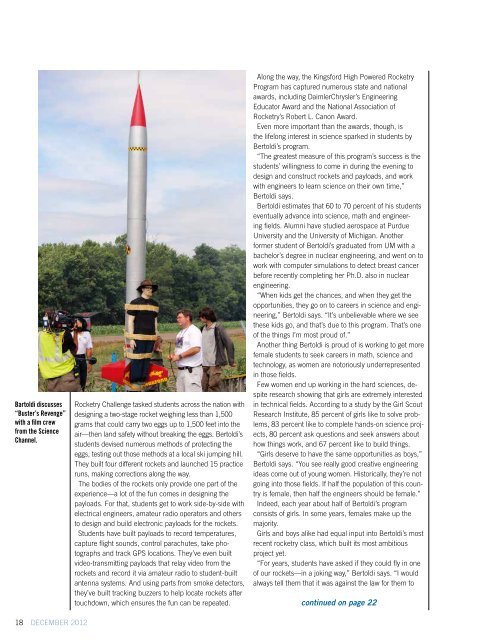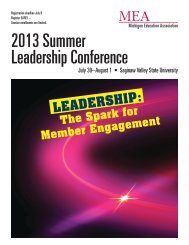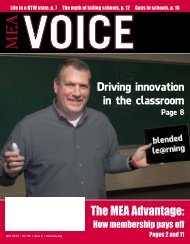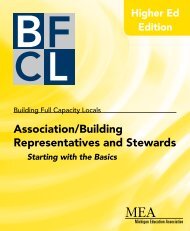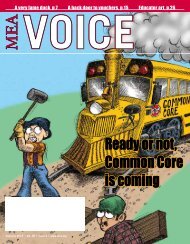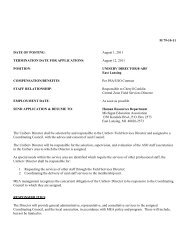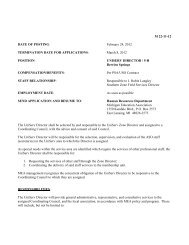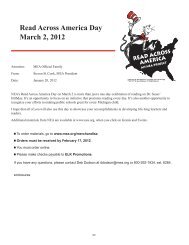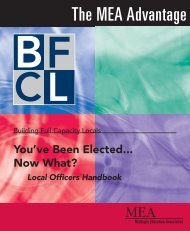2012 December - Michigan Education Association
2012 December - Michigan Education Association
2012 December - Michigan Education Association
Create successful ePaper yourself
Turn your PDF publications into a flip-book with our unique Google optimized e-Paper software.
Bartoldi discusses<br />
“Buster’s Revenge”<br />
with a film crew<br />
from the Science<br />
Channel.<br />
18 DECEMBER <strong>2012</strong><br />
Rocketry Challenge tasked students across the nation with<br />
designing a two-stage rocket weighing less than 1,500<br />
grams that could carry two eggs up to 1,500 feet into the<br />
air—then land safety without breaking the eggs. Bertoldi’s<br />
students devised numerous methods of protecting the<br />
eggs, testing out those methods at a local ski jumping hill.<br />
They built four different rockets and launched 15 practice<br />
runs, making corrections along the way.<br />
The bodies of the rockets only provide one part of the<br />
experience—a lot of the fun comes in designing the<br />
payloads. For that, students get to work side-by-side with<br />
electrical engineers, amateur radio operators and others<br />
to design and build electronic payloads for the rockets.<br />
Students have built payloads to record temperatures,<br />
capture flight sounds, control parachutes, take photographs<br />
and track GPS locations. They’ve even built<br />
video-transmitting payloads that relay video from the<br />
rockets and record it via amateur radio to student-built<br />
antenna systems. And using parts from smoke detectors,<br />
they’ve built tracking buzzers to help locate rockets after<br />
touchdown, which ensures the fun can be repeated.<br />
Along the way, the Kingsford High Powered Rocketry<br />
Program has captured numerous state and national<br />
awards, including DaimlerChrysler’s Engineering<br />
Educator Award and the National <strong>Association</strong> of<br />
Rocketry’s Robert L. Canon Award.<br />
Even more important than the awards, though, is<br />
the lifelong interest in science sparked in students by<br />
Bertoldi’s program.<br />
“The greatest measure of this program’s success is the<br />
students’ willingness to come in during the evening to<br />
design and construct rockets and payloads, and work<br />
with engineers to learn science on their own time,”<br />
Bertoldi says.<br />
Bertoldi estimates that 60 to 70 percent of his students<br />
eventually advance into science, math and engineering<br />
fields. Alumni have studied aerospace at Purdue<br />
University and the University of <strong>Michigan</strong>. Another<br />
former student of Bertoldi’s graduated from UM with a<br />
bachelor’s degree in nuclear engineering, and went on to<br />
work with computer simulations to detect breast cancer<br />
before recently completing her Ph.D. also in nuclear<br />
engineering.<br />
“When kids get the chances, and when they get the<br />
opportunities, they go on to careers in science and engineering,”<br />
Bertoldi says. “It’s unbelievable where we see<br />
these kids go, and that’s due to this program. That’s one<br />
of the things I’m most proud of.”<br />
Another thing Bertoldi is proud of is working to get more<br />
female students to seek careers in math, science and<br />
technology, as women are notoriously underrepresented<br />
in those fields.<br />
Few women end up working in the hard sciences, despite<br />
research showing that girls are extremely interested<br />
in technical fields. According to a study by the Girl Scout<br />
Research Institute, 85 percent of girls like to solve problems,<br />
83 percent like to complete hands-on science projects,<br />
80 percent ask questions and seek answers about<br />
how things work, and 67 percent like to build things.<br />
“Girls deserve to have the same opportunities as boys,”<br />
Bertoldi says. “You see really good creative engineering<br />
ideas come out of young women. Historically, they’re not<br />
going into those fields. If half the population of this country<br />
is female, then half the engineers should be female.”<br />
Indeed, each year about half of Bertoldi’s program<br />
consists of girls. In some years, females make up the<br />
majority.<br />
Girls and boys alike had equal input into Bertoldi’s most<br />
recent rocketry class, which built its most ambitious<br />
project yet.<br />
“For years, students have asked if they could fly in one<br />
of our rockets—in a joking way,” Bertoldi says. “I would<br />
always tell them that it was against the law for them to<br />
continued on page 22


